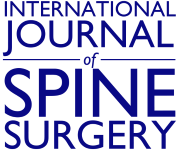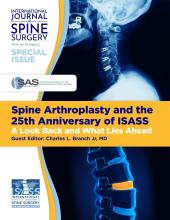Article Figures & Data
Tables
- Table
Radiological and clinical outcomes of ASD and AIS with patient-specific rod instrumentation.
Study Design Sample Size Major Takeaways Barton et al10 Retrospective case series ASD (N = 18) Reduction in SVA, PT, and PI−LL postoperatively
SVA: Preoperative: 96.8 ± 56.8 mm; postoperative: 21.8 ± 37.1 mm (P < 0.001)
PT: Preoperative: 32° ± 10.9°; postoperative: 17.7° ± 8.0° (P < 0.0001).
PI−LL: Preoperative: 29.2° ± 16.7°; postoperative: −4.1° ± 7.5° (P < 0.001)
Prost et al11 Prospective observational study ASD (N = 86) Improvement in sagittal balance at 1-year follow-up in patients with a high preoperative SVA
SVA: Preoperative: 53 ± 63 mm; postoperative: 30 ± 41 mm, (P = 0.007)
Improvement in PI−LL at 1-year follow-up for patients with a preoperative PI−LL mismatch
PI−LL: Preoperative: 15° ± 20°; postoperative: 8° ± 14° (P = 0.006)
18% of patients developed mechanical complications at 1-year follow-up
Prost et al7 Retrospective case series ASD and AIS
Total (N = 77)
ASD (N = 43)
AIS (N = 24)Improvement in PI−LL and SVA at 3-month follow-up for ASD patients
PI−LL: Preoperative: 20.8° ± 17.8°; postoperative: 8.3° ± 12.8° (P < 0.0001)
SVA: Preoperative: 77.3 ± 60.6 mm; postoperative: 41.9 ± 38.0 mm (P < 0.0001)
No significant improvements in PT for ASD patients
No significant improvements in PI−LL, SVA, and PT for AIS patients
Sadrameli et al12 Retrospective case series ASD (N = 17) No significant difference observed between planned SVA and achieved postoperative SVA
Significant improvements in PT, SS, LL, and SVA
PT: Preoperative: 24.82° ± 9.6°; postoperative: 18.00° ± 8.6° (P < 0.01)
SS: Preoperative: 28.65° ± 9.84°; postoperative: 36.53° ± 7.97° (P < 0.01)
Ferrero et al16 Retrospective case series AIS Reduction in mean coronal Cobb angle in Lenke Type 1 and Type 2 AIS patients
Preoperative: 59° ± 13°; postoperative: 18° ± 11° (P = 0.01)
Increase in postoperative thoracic kyphosis
Preoperative: 34° ± 14°; postoperative: 45° ± 12° (P = 0.001)
Mayra et al17 Retrospective case series AIS (N = 61) Reduction in proximal thoracic, main thoracic, and thoracolumbar curves in AIS patients
Proximal thoracic: 30.5° ± 10.2° to 15.6° ± 7.1° (P < 0.001)
Main thoracic: 68.5° ± 13.4° to 17.4° ± 9.0° (P < 0.001)
Thoracolumbar: 43.4° ± 14.2° to 15.5° ± 9.1° (P < 0.001)
Increase in thoracic kyphosis for hypokyphotic patients
Preoperative: 8.4° ± 9.5°; postoperative: 22° ± 3.7° (P = 0.0096)
Reduction in thoracic kyphosis for hyperkyphotic patients
Preoperative: 49.2° ± 7.7°; postoperative: 38.2° ± 9.5° (P = 0.001)
Thomas et al19 Retrospective case series AIS (N = 48) Reduction in median coronal thoracic curve at 2-year follow-up
Preoperative: 62.7°; postoperative 22.4° (P < 0.001)
Increase in median preoperative vs planned thoracic kyphosis
Preoperative: 26.5°; planned: 30.1° (P < 0.001)
Faulks et al24 Prospective case series ASD (N = 20) Significant improvements in PROs: VAS, ODI, and SF-12 at 6 weeks, 6 months, 12 months, and 24 months postoperatively
PSR instrumentation did not reduce junctional complications; however, a decreased rate of PJF was observed from previous studies (5% vs 35%)
Kleck et al25 Retrospective case series ASD (N = 34) Improvement in majority difference for SVA, LL, and PI−LL at 2-year follow-up (P < 0.001)
Ou-Yang et al27 Retrospective case series ASD (N = 57) Improvement in SVA and PI−LL postoperatively in PSR vs control but not statistically significant
Solla et al28 Prospective case series ASD (N = 60) Improvement in PI−LL, decreased mechanical complications, and reduced OR time
Solla et al32 Prospective case series AIS (N = 37) Improvement in coronal Cobb angle in patients with a minimum of 1-year follow-up (P = 0.03)
Increase in thoracic kyphosis at follow-up
Preoperatively: 20°; postoperatively: 35° (P < 0.0001)
Abbreviations: AIS, adolescent idiopathic scoliosis; ASD, adult spinal deformity; ODI, Oswestry Disability Index; OR, operating room; PI−LL, pelvic incidence minus lumbar lordosis; PJF, proximal junctional failure; PRO, patient-reported outcome; PSR, patient-specific rod; PT, pelvic tilt; SF-12, 12-item Short Form Survey; SVA, sagittal vertical axis; VAS, visual analog scale.







